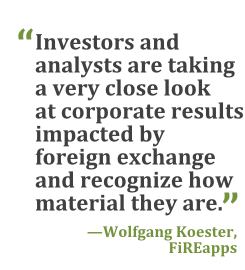Volatility in the US$5.3-trillion-a-day foreign exchange (FX)market is dragging down U.S. corporate earnings by the mostsince 2011, according to a report from FiREapps.
|Currency fluctuations eroded earnings for the averageNorth American company by 12 cents per share in the third quarterof 2015, according to the Scottsdale, Arizona-based firm, whichadvises businesses and makes software to help reduce the effect offoreign-exchange swings. That's the most in data going back atleast four years, and is up from an average 3 cents per sharein the second quarter.
| “Thisis the worst I've seen it,” FiREapps chief executive officerWolfgang Koester said in a telephone interview. “Investors andanalysts are taking a very close look at corporate results impacted by foreign exchange and recognizehow material they are.”
“Thisis the worst I've seen it,” FiREapps chief executive officerWolfgang Koester said in a telephone interview. “Investors andanalysts are taking a very close look at corporate results impacted by foreign exchange and recognizehow material they are.”
A JPMorgan Chase & Co. measure of currency volatilityaveraged 10.1 percent during the third quarter, up from 6.3 percent12 months earlier. Last year, some of the biggest price swings camefrom unscheduled events, such as China's August devaluation of the yuan, Switzerland's decision to scrap its currency cap, andplummeting commodity prices.
|Companies in North America lost at least $19.3 billion toforeign-exchange headwinds in the third quarter of 2015, FiREappsdata showed. The losses grew by about 14 percent from the secondquarter. Of the 850 North American corporations that Fireappsanalyzed, 353 cited the negative impact of currencies in theirearnings, more than double the previous quarter.
|“That is the largest number of companies talking about currencyimpact that we've ever seen,” Koester said.
|Profit in 2015 at Kimberly-Clark Corp., the maker of Kleenextissues and Huggies diapers, was reduced by about 25 percent bycurrency effects, Tom Falk, the company's chief executiveofficer, said in an interview with Bloomberg Television.
|China's yuan is garnering more attention from corporations amidconcern that growth in the world's second-largest economy isslowing, according to FiREapps.
|Yet North American firms remain most concerned about the effectsof the euro, Brazilian real, and Canadian dollar on their results. The currencies have fallen7.8 percent, 34 percent, and 16 percent against the greenback overthe past 12 months. The stronger U.S. dollar means higher,less-competitive prices for U.S. businesses seeking to sell theirproducts overseas. Companies also take a hit when they account for revenue denominatedin weaker overseas currencies, unless they hedged theirexposure.
|European companies suffered currency-linked losses of $4.7billion for the third quarter, up from $2.5 billion for theprevious period.
|–With assistance from Liz Capo McCormick.
|Copyright 2018 Bloomberg. All rightsreserved. This material may not be published, broadcast, rewritten,or redistributed.
Complete your profile to continue reading and get FREE access to Treasury & Risk, part of your ALM digital membership.
Your access to unlimited Treasury & Risk content isn’t changing.
Once you are an ALM digital member, you’ll receive:
- Critical Treasury & Risk information including in-depth analysis of treasury and finance best practices, case studies with corporate innovators, informative newsletters, educational webcasts and videos, and resources from industry leaders.
- Exclusive discounts on ALM and Treasury & Risk events.
- Access to other award-winning ALM websites including PropertyCasualty360.com and Law.com.
*May exclude premium content
Already have an account? Sign In
© 2024 ALM Global, LLC, All Rights Reserved. Request academic re-use from www.copyright.com. All other uses, submit a request to [email protected]. For more information visit Asset & Logo Licensing.







